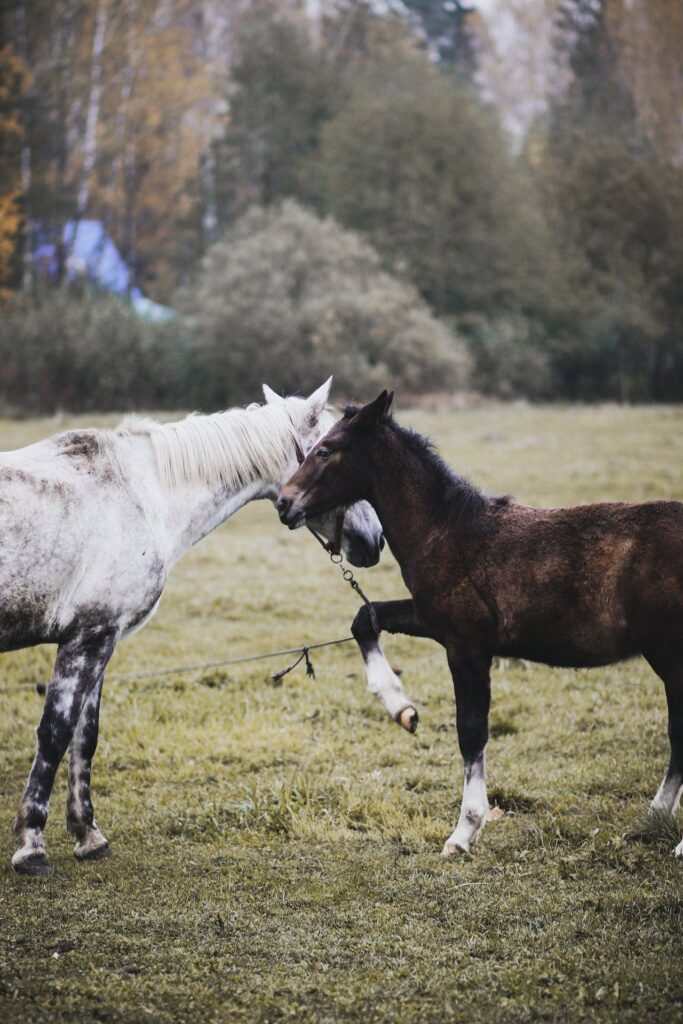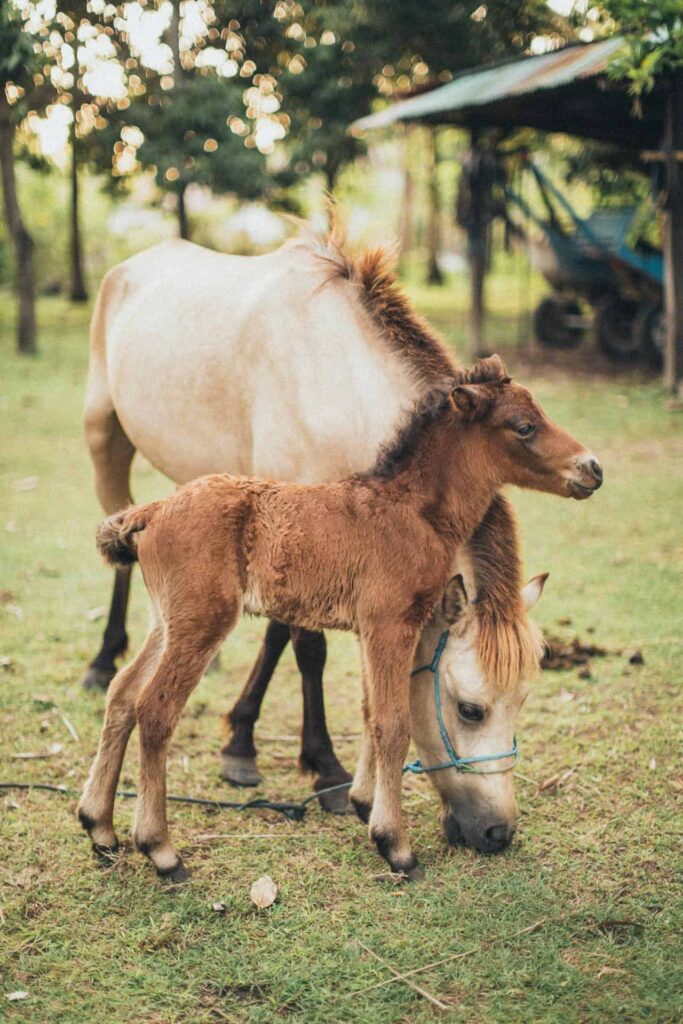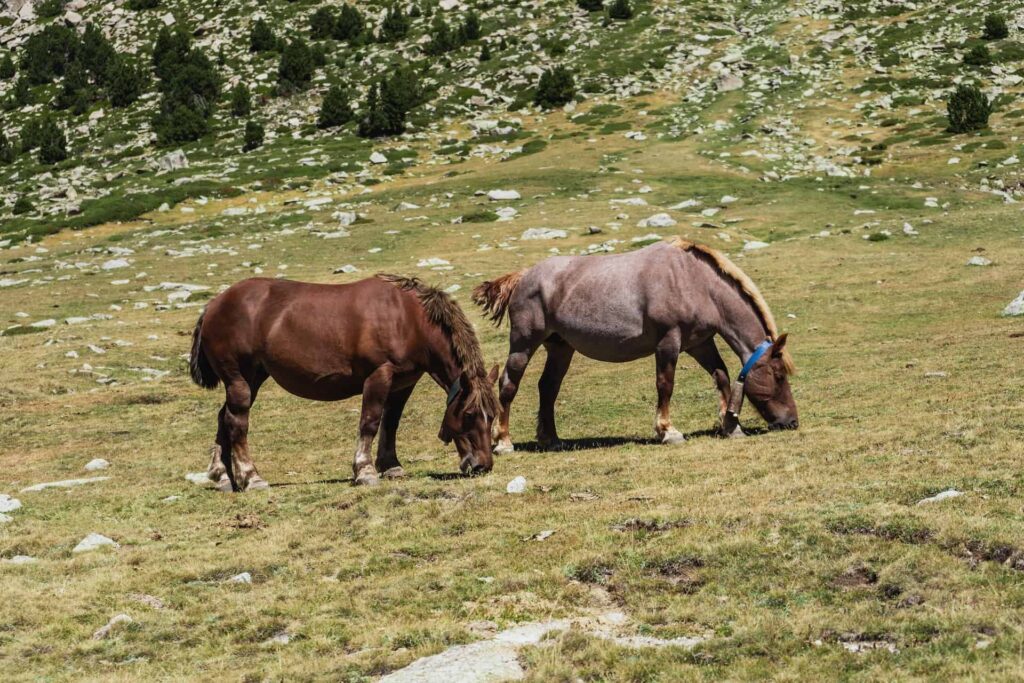Horse pregnancy, also known as gestation, is a fascinating subject for horse enthusiasts and breeders alike. Understanding how long are horses pregnant, and the stages of pregnancy in horses is necessary for proper care and management during this time. On average, horses are pregnant for 11 months, or about 340 days, although gestation length can slightly vary depending on factors such as breed, age, and health.
During the gestation period, it’s important to recognize the signs of pregnancy and keep a watchful eye on the mare’s health. Proper care, including a balanced diet, exercise, and regular veterinary checkups, ensures a healthy pregnancy and foaling process. Additionally, being prepared and informed about possible complications during foaling can help ensure the well-being of both mare and foal.
Key Takeaways
- Horses have an average pregnancy length of 11 months or about 340 days
- Monitoring the mare’s health and ensuring proper care during pregnancy is crucial
- Understanding potential complications can help maintain the well-being of the mare and foal during foaling
Understanding Horse Pregnancy
Horse pregnancy, also known as gestation, is a fascinating and complex process that occurs in horses when they become pregnant. The average gestation period for horses is approximately 11 months, or about 335 to 342 days, though this duration may vary slightly depending on breed, age, and health of the mare.
During the first few weeks of pregnancy, the fertilized embryo begins to develop rapidly. Around day 22, a heartbeat can typically be detected, signaling a healthy and progressing pregnancy. The gestation process in horses can be divided into three trimesters, each with unique milestones and growth stages.
The first trimester of horse pregnancy involves the rapid development of the embryo. The embryo attaches to the lining of the mare’s uterus around day 16 and continues to grow and differentiate into various tissues. This initial stage is critical for the successful establishment of pregnancy, and mares should be closely monitored during this time.
During the second trimester, the fetus undergoes significant growth, and its organs and systems begin to mature. At this stage, the pregnant mare may start to show visible signs of pregnancy, such as an increase in abdominal size. It is important to maintain proper nutrition and care for the mare, as this is a critical period for fetal development.
The third and final trimester of horse pregnancy is marked by rapid fetal growth and preparation for birth. The mare’s body will undergo a series of changes to accommodate the growing fetus and prepare for the birthing process. As the due date approaches, close monitoring of the mare’s health and comfort to ensure a smooth and successful foaling.
Understanding the stages of horse pregnancy and the gestation length allows horse owners and veterinarians to better care for pregnant mares. By monitoring the health and progress of both the mare and fetus throughout the pregnancy, complications can be detected and addressed early, improving the chances of successful and healthy foaling.

Signs of Pregnancy
Identifying a mare’s pregnancy is the first step in providing adequate care for both the mare and her developing foal. Monitor for any signs of pregnancy in a mare, as timely veterinary attention can greatly enhance the well-being of both animals. Some of the common signs of pregnancy in mares include changes in behavior, physical changes, and confirmation through ultrasound examinations.
Behavioral changes in a pregnant mare may be subtle or apparent. One of the first noticeable signs is the cessation of estrus cycles or a change in the frequency or duration of estrus. Pregnant mares will often display a more relaxed demeanor and may show signs of increased bonding with other horses.
Physical changes in a mare during pregnancy can also be indicative of her condition. The mare’s abdomen will gradually enlarge as the fetus grows, and her udder may begin to swell a few weeks before foaling. Pregnant mares may experience weight gain, and their appetite might increase as well.
A veterinarian can confirm pregnancy through an ultrasound examination. Ultrasounds are a reliable and noninvasive method to detect pregnancies as early as 14-15 days after ovulation. Owners should consult a veterinarian regarding the optimal timing and frequency of ultrasound examinations during the mare’s pregnancy.
Regular vet check-ups and careful observation are necessary aspects of mares’ care during pregnancy. As the due date approaches, it is critical to be vigilant for any signs of complications or distress, such as hydramnios or early labor. Providing a clean, comfortable, and stress-free environment can support the mare’s well-being throughout her pregnancy.
Recognizing the signs of pregnancy in a mare is vital for proper care and management. Timely veterinary consultation through regular check-ups and ultrasound examinations contributes to ensuring a healthy and successful pregnancy for both the mare and the developing foal.
Factors Influencing Pregnancy
Horses, being seasonally polyestrous animals, experience variations in pregnancy length due to several factors. One major aspect that influences gestation is the mare’s age. As they grow older, mares may have a longer gestation period compared to their younger counterparts (source).
Seasonal effects also play a significant role in influencing the duration of a horse’s pregnancy. Mares bred during certain seasons, especially in spring, tend to have slightly longer gestation periods (source). Environmental factors, such as temperature and photoperiod, are believed to have a direct impact on the mare’s reproductive physiology, and consequently the pregnancy length.
Furthermore, the sex of the foal can affect on the gestation period. Studies have shown that pregnancies with colt foals generally have a slightly longer gestation length compared to pregnancies with filly foals (source). This difference may be attributed to the genetic and physiological factors of the developing foal.
While political aspects may not have a direct influence on the duration of a horse’s pregnancy, they can indirectly affect it through the implementation of breeding policies and regulations. Policies focused on the welfare and proper management of pregnant mares may lead to better reproductive outcomes and optimal gestation lengths.
The mare’s age, seasonal effects, the sex of the foal, and breeding policies can contribute to variations in a horse’s pregnancy length. Understanding these factors can help horse breeders and owners to better manage and monitor the health and well-being of mares during gestation.
Health and Care During Pregnancy
During a horse’s pregnancy, the owner or caretaker needs to ensure proper health and care for the pregnant mare. Regular visits from a veterinarian are advised throughout the pregnancy, as it can last for approximately 11 months, to monitor the development of the foal and the mare’s well-being.
Nutrition and Diet: Provide a balanced diet for the pregnant mare to promote healthy growth and development. The mare’s diet should consist of good quality forage, such as hay or grass, high-quality concentrates, and the necessary minerals and vitamins. Proper nutrition not only benefits the mare but also affects the foal’s bone and glucose metabolism which can impact its future performance.
Exercise: Exercise is beneficial throughout the pregnancy to maintain the mare’s physique and endurance. It also helps the mare to prepare for birth and recover more swiftly postpartum. Gentle exercise, like hand walking or light riding, is beneficial in the early and mid stages of pregnancy, while significantly more limited exercise is advised as the mare approaches her due date.
Body Condition: Keeping the mare in optimal body condition is vital for her health and that of the developing foal. Underweight or overweight mares may face complications during pregnancy and birth. A veterinarian can examine the mare and provide recommendations to help maintain the appropriate body condition by adjusting its diet and exercise program.
Supplementation: Pregnant mares may require additional nutritional supplementation, particularly during the last trimester when the foal’s growth rapidly increases. A veterinarian can examine the mare’s diet and prescribe appropriate supplements including vitamins, minerals, and amino acids to promote proper growth and development.
Vaccinations and Blood Tests: Regular blood tests are necessary to ensure that the pregnant mare does not have any infections or deficiencies that may impact the foal’s health. Vaccinations, like those for Influenza and Tetanus, play a role in providing both the mare and foal with immunity against diseases. A veterinarian can administer the necessary vaccines during the pregnancy.
Monitoring for Premature Birth: Premature birth in horses can lead to various health issues for the foal, including weakened immunity and development complications. Veterinarians can conduct regular ultrasounds to monitor the foal’s progress and identify if there are any signs of a premature birth. In such cases, taking swift action may result in better outcomes for the mare and foal.
Prioritizing the health and care of a pregnant mare involves regular veterinarian checkups, adequate exercise, balanced nutrition, proper supplementation, and appropriate vaccinations. Providing this comprehensive care throughout pregnancy will potentially result in better reproductive outcomes and future performance for both the mare and the foal.
The Foaling Process
The foaling process is an important stage in a horse’s reproductive cycle. It begins with the mare going into labor and ends with the delivery of the foal. Foaling can be a complex and sometimes stressful process for both the mare and her handlers, but understanding the various stages of labor and delivery can help ensure a successful outcome.
During the foaling process, the mare’s body undergoes several major changes to facilitate the delivery of the foal. As labor progresses, the mare may exhibit signs of discomfort such as pacing, pawing at the ground, or even signs of colic. These behaviors are normal and usually indicate that the mare is contracting and preparing for the delivery of her foal.
The first stage of labor typically lasts for several hours and involves the relaxation of the mare’s cervix, allowing the foal to move into the birth canal. During this stage, the mare may also produce a thick mucus discharge, which helps to lubricate the birth canal and ease the passage of the foal.
The second stage of labor is the actual delivery of the foal. This stage can be quite rapid, often taking less than 30 minutes. The mare will usually lie down on her side and push with strong contractions to expel the foal. The foal’s front legs and head will emerge first, followed by the rest of its body. Once the foal has been delivered, make sure that its airways are clear of any mucus or fluid, allowing it to take its first breaths.
The final stage of the foaling process is the expulsion of the placenta, which usually occurs within a few hours of the foal’s birth. It is important for handlers to closely monitor this stage, as a retained placenta can lead to serious health complications for the mare.
Throughout the foaling process, handlers need to be attentive and prepared to intervene if complications arise. Many mares can successfully deliver their foals without intervention. Understanding the stages of labor and the signs of a healthy delivery can help ensure the best possible outcome for both the mare and her foal.
Related: Mares and Foaling: Breeding and Birth Management Guide
Possible Complications
During the pregnancy of a horse, there is a potential for various complications to arise. One such complication is the occurrence of twin pregnancies. Twin pregnancies are typically undesirable in horses, as they often lead to pregnancy loss or complications for both the mare and the foals. Breeders should monitor for the presence of twins and potentially reduce the pregnancy to a single foal for better outcomes.
Colic is another possible issue that may arise in pregnant mares. Colic refers to abdominal pain, which can be a result of various gastrointestinal issues like gas, impaction, or torsion of the intestines. Horse owners and caretakers need to recognize the signs of colic and seek prompt veterinary assistance to minimize complications. Untreated colic may pose severe risks for both the mare and the unborn foal.
Prolonged gestation is another complication that may occur in pregnant horses. Normally, horses have a gestation period of approximately 11 months, although it can slightly vary between individuals. A significantly prolonged pregnancy can potentially lead to difficulties during foaling and increased risks for the mare and foal. Possible reasons for an extended pregnancy include issues with the placenta, infections, or hormonal imbalances.
Horse owners and caretakers need to closely observe their pregnant mares to ensure the detection of any potential complications. Prompt veterinary intervention is necessary to manage and mitigate the risks associated with these complications, thus safeguarding the well-being of both the mare and the unborn foal.
Post Pregnancy Care
After a mare gives birth, a veterinarian should be involved in this process to provide professional guidance and monitor the health of both animals.
One vital aspect of post-pregnancy care is supporting the health of the mare. The mare may need assistance in regaining her body weight, as pregnancy and nursing can cause significant weight loss. Providing a balanced diet, including high-quality hay and possibly a gradual introduction of grain, will assist in weight gain and overall health improvement. Care should also be taken not to expose the mare to fescue, as it can negatively impact milk production.
Beyond proper nutrition, the mare’s udders should be regularly checked for any signs of infection or inflammation. The veterinarian may recommend applying a dewormer to maintain the mare’s health and prevent parasitic infections.
The foal’s health is equally as important. Ensuring the foal receives colostrum from the mare within the first hours of life is a must, as it provides essential nutrients and antibodies to boost the newborn’s immune system. Monitoring the foal’s nursing habits and behaviors can help to identify any issues early on.
It is also important to have the foal examined by a veterinarian to assess its health and check for any congenital issues. Early visits to the veterinarian are beneficial for administering any necessary vaccinations or treatments specific to the foal’s needs.
In summary, proper post-pregnancy care for horses involves attention to the health of both the mare and the foal. Through working with a knowledgeable veterinarian, maintaining a nutritious diet, and monitoring the well-being of both animals, horse owners can ensure a successful transition for the mare and her newborn.
Breeders Perspective
From a breeder’s perspective, understanding the duration of a horse’s pregnancy will ensure a successful horse breeding program. The average gestation period for a mare is approximately 11 months, or more specifically, 340 days. This can vary slightly depending on breed, environmental conditions, and individual differences between mares.
A key aspect of horse breeding is selecting the right time for mating, which typically revolves around the breeding season. For most breeds, this season typically extends from early spring to late summer. During this time, mares are more receptive to being bred by stallions, increasing the chances of a successful pregnancy.
In addition to timing, breeders also carefully select the most genetically compatible mare and stallion pairings. This decision can significantly impact the development of a viable foal, as well as the success of the breeding program. A well-matched pair can produce offspring that are strong, healthy, and exhibit desirable traits valuable to the breed.
Throughout the pregnancy, the mare’s health and nutrition are closely monitored, as this can have a direct influence on the development and health of the unborn foal. This attention to detail is important in fostering a successful pregnancy and reducing the risk of complications during birth.
When the pregnancy nears its end, breeders keep a close eye on mares for any signs of labor, to ensure a safe delivery. The birth of a foal often takes place without complications; however, breeders need to be prepared for any potential issues to guarantee the well-being of both the mare and the foal.
In conclusion, the pregnancy period of a horse is lengthy and involves careful preparation, planning, and monitoring from the perspective of the breeder. The knowledge and expertise of breeders play a significant role in the successful delivery of a healthy, viable foal, and the ongoing development of the breed.

Related: How Much Does a Foal Cost
Veterinary Perspective
From a veterinary point of view, the gestation period of a horse can vary, but it generally lasts around 11 months (approximately 340 days). Veterinarians utilize various diagnostic techniques to monitor and ensure healthy pregnancies in horses. These methods include rectal palpation, ultrasound, vaccinations, urine testing, and blood tests.
In the early stages of an equine pregnancy, a veterinarian might perform a rectal palpation to confirm the presence of a developing fetus. This technique allows the vet to physically feel the uterus and identify any potential abnormalities in the pregnant mare. As the pregnancy progresses, ultrasound becomes the preferred method for monitoring fetal growth and development. Through ultrasound, veterinarians can accurately visualize the fetus, its heartbeat, and the growth of various fetal structures.
Preventive care, such as vaccinations, helps to protect the mare and the developing fetus against common equine diseases that may pose a significant risk during pregnancy. Consult with a veterinarian to determine the appropriate vaccination schedule for a particular horse.
Urine testing and blood tests are tools that veterinarians may use to monitor the well-being of pregnant horses. These tests can provide valuable information about the mare’s overall health, hormone levels, and potential exposure to infectious diseases. In some cases, blood tests may also help to identify any nutritional imbalances or deficiencies that could negatively impact the pregnancy.
In summary, from a veterinary perspective, the gestation period of a horse typically lasts around 11 months. Proper monitoring and management, including rectal palpation, ultrasound, vaccinations, urine testing, and blood tests, ensure a successful pregnancy and the health of both the mare and the developing fetus. Veterinarians play a necessary role in providing comprehensive care and guidance to horse owners throughout the entire pregnancy process.
Frequently Asked Questions
What are the stages of horse pregnancy?
Horse pregnancy is divided into three stages:
- First trimester: The fertilized egg travels through the fallopian tubes and implants into the uterus. During this time, the developing embryo is mostly unaffected by the mare’s behavior or environment.
- Second trimester: This is the period of rapid fetal growth, and the mare’s nutritional needs increase. Foal development and the mare’s weight gain become more noticeable.
- Third trimester: As the foal continues to grow, the mare’s energy requirements increase even further. During this stage, the mare prepares for birth by producing milk and her belly expands significantly.
How can I determine the pregnancy period of a horse?
Horses have a gestation period of approximately 11 months, although the length can vary slightly depending on the individual mare. Veterinarians can use ultrasound or blood tests to confirm pregnancy and monitor the progress of the fetus.
What are the mare behaviors during pregnancy?
Pregnant mares typically exhibit few behavioral changes. Some may experience mood swings and show subtle signs of discomfort as the pregnancy advances. In the final weeks of gestation, a mare may become less active and display signs of restlessness or nesting behavior.
What’s the record for the longest horse pregnancy?
The record for the longest horse pregnancy is around 445 days, although most pregnancies last between 320 to 365 days. Factors contributing to a longer pregnancy may include the mare’s health, breed, and environmental conditions.
How does a pregnant horse’s belly appear?
As the pregnancy progresses, a mare’s belly will gradually expand due to the growing fetus. It is most noticeable during the third trimester when the foal reaches its maximum size. Towards the end of gestation, the mother’s belly may appear to drop as the foal positions itself for birth.
When does a horse embryo fully develop?
A horse embryo completes its development around the 150th day of gestation. During this time, the foal acquires its skeletal structure, muscles, and organs. It continues to grow and develop until birth, when it emerges as a fully formed, although immature, individual.
Last Updated on February 27, 2024 by Nate Dewsbury



